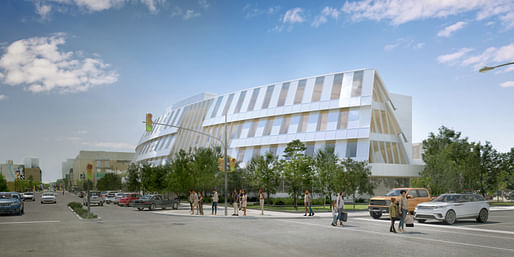
A joint team of Formline, Chevalier Morales, and Montreal’s Architecture49 has revealed its design for a new library project in Saskatoon, Saskatchewan.
The firms say the project is conceived as a “pillar in the reconciliation of Indigenous and Western ways of living and building” that will serve as an important precedent as the first “major public building” in an area with the highest ratio of Indigenous residents of any other major city in the country.
The new central library will link to the nearby Remai Modern Gallery and several small shops near the site to form a small new cultural hub along Second Avenue. The design team says it was directed by the city’s relatively low park-to-person ratio in the selection of form, materials, and the arrangement of public spaces in and around the 142,000-square-foot structure. Overall, some 45% of the site will include landscaped public spaces punctuated by the building's oval footprint.

Per the architects: “The geometry and plan strategies will be enforced in building sections along the triple-glazed perimeter windows along Second Avenue, which will step back with angled surfaces, evoking the iconic form, lightness, and luminosity of teepees.”
“The transparent and translucent skin of the building will take advantage of and diffuse the crisp natural light of the prairies. Inspired by the Saskatchewan landscape and local architecture traditions, the library will also evoke the Métis log cabin with exposed glulam beams and a cross-laminated timber strategy that not only provides structure but also psychic warmth.”
That strategy is enacted with a timber structure placed on top of a concrete plinth. Glulam slab bands resonate outwardly from the plinth and angled GLT columns are further placed along the Second Avenue elevation. A series of lapped glass panels are finally installed into the facade to allow for air intake and natural ventilation.
Inside, a children’s theater, cafés, community kitchen, and brightly lit learning sharing circle highlight the project’s public-serving scope. The finished product comes completed with considerations for accessibility, wayfinding, and gathering space. In a press release, the firms promoted its design as a “showcase [for] the best of library design and community-building for the Reconciliation Era and generations to come.”
No Comments
Block this user
Are you sure you want to block this user and hide all related comments throughout the site?
Archinect
This is your first comment on Archinect. Your comment will be visible once approved.